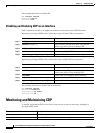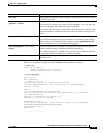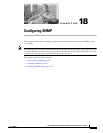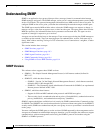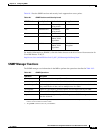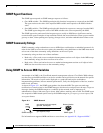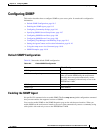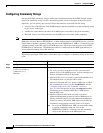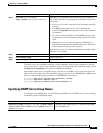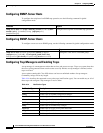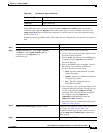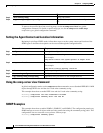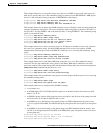
18-4
Cisco IOS Software Configuration Guide for Cisco Aironet Access Points
OL-11350-01
Chapter 18 Configuring SNMP
Understanding SNMP
SNMP Agent Functions
The SNMP agent responds to SNMP manager requests as follows:
• Get a MIB variable—The SNMP agent begins this function in response to a request from the NMS.
The agent retrieves the value of the requested MIB variable and responds to the NMS with that
value.
• Set a MIB variable—The SNMP agent begins this function in response to a message from the NMS.
The SNMP agent changes the value of the MIB variable to the value requested by the NMS.
The SNMP agent also sends unsolicited trap messages to notify an NMS that a significant event has
occurred on the agent. Examples of trap conditions include, but are not limited to, when a port or module
goes up or down, when spanning-tree topology changes occur, and when authentication failures occur.
SNMP Community Strings
SNMP community strings authenticate access to MIB objects and function as embedded passwords. In
order for the NMS to access the access point, the community string definitions on the NMS must match
at least one of the three community string definitions on the access point.
A community string can have one of these attributes:
• Read-only—Gives read access to authorized management stations to all objects in the MIB except
the community strings, but does not allow write access
• Read-write—Gives read and write access to authorized management stations to all objects in the
MIB, but does not allow access to the community strings
Using SNMP to Access MIB Variables
An example of an NMS is the CiscoWorks network management software. CiscoWorks 2000 software
uses the access point MIB variables to set device variables and to poll devices on the network for specific
information. The results of a poll can be displayed as a graph and analyzed to troubleshoot
internetworking problems, increase network performance, verify the configuration of devices, monitor
traffic loads, and more.
As shown in Figure 18-1, the SNMP agent gathers data from the MIB. The agent can send traps
(notification of certain events) to the SNMP manager, which receives and processes the traps. Traps are
messages alerting the SNMP manager to a condition on the network such as improper user
authentication, restarts, link status (up or down), MAC address tracking, and so forth. The SNMP agent
also responds to MIB-related queries sent by the SNMP manager in get-request, get-next-request, and
set-request format.
Figure 18-1 SNMP Network
For information on supported MIBs and how to access them, see Appendix B, “Supported MIBs.”
get-request, get-next-request,
get-bulk, set-request
Network device
get-response, traps
81949
SNMP manager
NMS
MIB
SNMP agent



